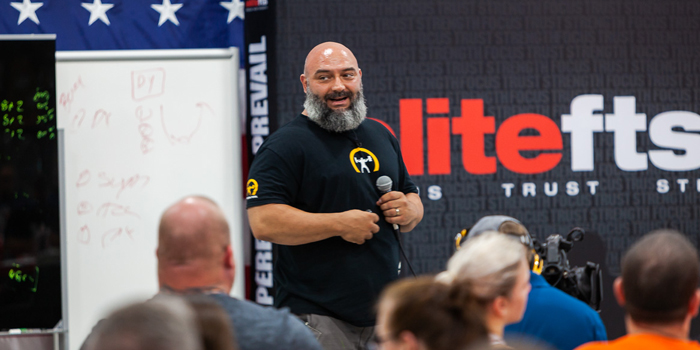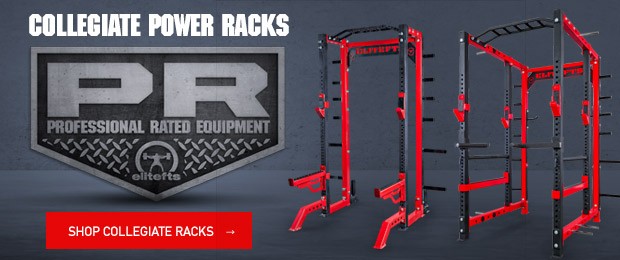
The elitefts Learn To Train X (LTTX) seminar took place in early August, bringing together trainers, coaches, athletes, and competitors across the powerlifting industry for the intensive three-day event. Participants were able to attend lectures from respected strength and performance educators, and also had the opportunity to experience hands-on instruction at training stations dedicated to perfecting squat, bench press, and deadlift techniques. As part of the lecture series, Nate Harvey spoke to the group about some simple techniques that can have a big impact on athletic performance.
In this presentation, Harvey goes back to the often-neglected and rarely taught basics. His first “simple technique”, is a detailed breakdown of how to box squat correctly. Although seemingly simple, the checklist that he provides to the audience is something that may be easier said than done. In fact, athletes that can execute a proper box squat in alignment with Harvey’s criteria are undoubtedly faster, stronger, and more agile.
On the Front Lines
Harvey starts out by acknowledging that much of the content from his presentation is not necessarily echoed in industry research journals. Although research can be valuable, it tends to lag behind real-time training innovation that’s taking place in the gym or the weight room. And that’s where Harvey’s expertise lies – he’s lived out what he’s preaching and witnessed the results of doing so. Chuckling, he quotes a famous line from Jim Wendler:
You want science and studies? Fuck you – I’ve got blood, and scars, and vomit.
His point is well-taken. Cutting-edge training technique and forward-looking programming has not necessarily been researched and validated just yet. In fact, those lifters and athletes training on the front lines are apt to make discoveries faster than a scientist with a microscope and a lab coat. And with that, Harvey tees up his presentation on perfecting foundational technique; without mastering these movements, nothing else will really make a difference.
Proper Box Squat Technique
The first rule when it comes to proper box squat technique is to ensure that the height is set correctly – this means working with a perpendicular shin. Next, the feet must be positioned in a wide stance. Although it’s okay to do a close-stance box squat once in a while as a variation, overall, an athlete’s feet should be placed out wide. As Harvey explains, there are two key criteria that will help get the feet into the proper position. The first is acknowledging that the stance will be a little uncomfortable for the athlete – this is normal. Secondly, the foot must be out far enough such that when the athlete is on the box and stands up, there is some lateral pressure going out on the side of the shoe.
Harvey notes that a significant amount of time in training is spent focusing on this wide, squat stance. Why? Because so much of the time on the athletic field is spent in exactly that stance (think: football players preparing for the next play). And yet, athletes are typically weak in this area, and thus training to develop the hips and the hamstrings is crucial for success.
When sitting on the box, Harvey advises that the crease of the athlete’s hip and the top of their kneecap should ideally be parallel to the floor. This position may look slightly skewed depending on the specific build of the individual. For athletes, a good rule of thumb is that if the femur is essentially parallel to the floor, then technique is relatively on-point. Once the lower body is solid, athletes should then focus on their shoulders. Specifically, they should be driving them into the bar. Too often, athletes treat this movement like a leg press and just stand up. In reality, there should be some intentional acceleration into the bar, with the pressure going out on the feet.
Squatting with Chains
Harvey discusses another option for speed squats that he has seen be effective for his athletes: squatting with chains. Similar to the box, this serves to break up the concentric and eccentric movements, thereby making the athlete more explosive. In any sport, explosiveness, or “first-step quickness” as Harvey puts it, is critical. And yet, many athletes struggle with agility and the ability to quickly change direction – despite having to do so on the field of play.
To prepare to squat with chains, Harvey instructs the group to first set up the J-cup, put the safety pins in the rack, drape the chain over that, and then go in a couple of links. Ideally, this would put the athlete in a roughly parallel position. Because this type of squat is harder and more stressful than a box squat, if an athlete is not entirely parallel, that’s okay. Harvey also recommends waving this movement in and out of training to avoid over-exerting the athlete.
As the group watches a demonstrative video, the snap coming out of the chain is visible with the squatting movement. Pointing it out, Harvey emphasizes that this will ultimately help athletes not only jump higher and run faster, but also help their max effort work have dynamic correspondence to the field. And for any coach, that’s exactly what they want to see.









